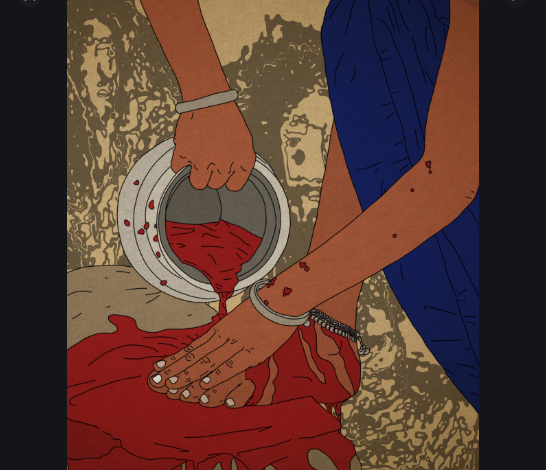Caste in Indian Sexuality: Reading Jayawant Hire’s Namantar

Babasaheb Ambedkar, in his essay, The Rise and Fall of Hindu Women, implied that women’s liberation reached its pinnacle in India during the Buddhist era. That was when women were allowed to be ascetics and monks and lead their lives away from the patriarchal household systems. This essentially intellectual liberation had women writing poetry (collected as the Therigatha) and enjoying life, while discovering the new meanings of life within the Buddhist Sangha. This is when Buddhism was becoming popular among many, especially women of all castes, and caste norms were crumbling like rotten trees.
The Brahmins, as Ambedkar explained, were upset and enraged that their oppressive hegemony was being dismantled. His theory was that the Manusmriti had been written after this period, and the strictest and most harsh rules were imposed upon women to stop the growth and spread of Buddhism. Thus with Manusmriti began the ugliest enslavement of women in India. She, especially the Savarna woman, was turned into a gatekeeper of caste. The tradition of Sati emerged to stop Savarna women from mixing with men from other “lower” castes. Sati was the practice of burning alive a Savarna woman on the funeral pyre of her husband. The husband’s death made her a surplus woman and a danger to the caste system. On this most inhuman practice Ambedkar said in his seminal paper, "Castes in India":
“…burn her on the funeral pyre of her deceased husband and get rid of her. This, however, is rather an impracticable way of solving the problem of sex disparity. In some cases it may work, in others it may not. Consequently every surplus woman cannot thus be disposed of, because it is an easy solution but a hard realization. And so the surplus woman (= widow), if not disposed of, remains in the group: but in her very existence lies a double danger. She may marry outside the Caste and violate endogamy, or she may marry within the Caste and through competition encroach upon the chances of marriage that must be reserved for the potential brides in the Caste. She is therefore a menace in any case, and something must be done to her if she cannot be burned along with her deceased husband.
Also read | Dalit Literature: On Memory or Death
“The second remedy is to enforce widowhood on her for the rest of her life. So far as the objective results are concerned, burning is a better solution than enforcing widowhood. Burning the widow eliminates all the three evils that a surplus woman is fraught with. Being dead and gone she creates no problem of remarriage either inside or outside the Caste. But compulsory widowhood is superior to burning because it is more practicable. Besides being comparatively humane it also guards against the evils of remarriage as does burning; but it fails to guard the morals of the group. No doubt under compulsory widowhood the woman remains, and just because she is deprived of her natural right of being a legitimate wife in future, the incentive to immoral conduct is increased. But this is by no means an insuperable difficulty. She can be degraded to a condition in which she is no longer a source of allurement.”1
So burn her and get rid of her body or disfigure her to mutilate her sexual desires, so that none would feel desire, sexual or romantic, for her. Both these inhumane tactics of brahmins were intended to keep the “purity” of their caste intact and restrict the sexuality of Savarna women to Savarna men in a forceful and unnatural manner. No non-Savarna man should have sex with her even if she consents: her body and lifespan converted into a property of Savarna men. Thus began her alienation from her sexuality as it was forcefully limited to Savarna men.
By chance, if she developed sexual or romantic feelings for men outside her caste, she had no choice but to “be with” and “be for” Savarna men or inhumane punishments were awaiting her. Her choices were ripped away from her; her will was morphed. Yet, interestingly, remaining with Savarna men, she witnessed herself as being privileged compared with other men, especially dalit men. Being a Savarna woman, the social gaze directed at her was one of respect, and she became a subject of infatuation for non-Savarna men, whereas dalit men and women were looked down upon and despised by society. In this process, the Savarna woman’s sexual liberty was taken away but her social privileges remained greater than that of dalit men and other women. This has created a split in her social behaviour: she wants to exercise her choice in terms of her sexual needs, but she is not willing to risk her privileges. None can explain this better than the story “Namantar” by Jayawant Hire.
Hire’s Marathi short story collection, Manus (Human Being), was published in 1988. Namantar is the most remarkable story in the collection. It stands out because of how caste is metaphorised through the sexuality of a female Savarna character. Even in the dalit literature that was written before this story was published, caste was rarely exposed in such a lucid manner, with so much nuance; explicitly told and yet profoundly intricate to understand.
Namantar is the story of Yashoda, a maratha woman, who is married to Balwant Patil, also a maratha by caste, who conceives a child by Namu Mahar, alias Namdeo Kamble, who belongs to the mahar (untouchable) caste. Yashoda cannot conceive a child from her marriage and everyone curses her for being infertile, though it is her husband who is impotent. To protect her husband, a caste-proud maratha man, Yashoda, the woman, is made a scapegoat and cursed for the inability of a man of the same caste.
Sexually unsatisfied in her marriage and bearing Savarna society’s burden, she faces a dilemma: how can she acquire sexual satisfaction as well as pregnancy, while preserving caste norms. Secrecy is her only way out, pretension her only weapon. Illusion is the only liberation, it seems to her.
Namu Mahar works at Patil’s mansion as an unpaid labourer. Yashoda could not but avoid seeing him work in her house every day.
“At the back door, Namu Mahar was cutting firewood to prepare the food. There was a pile of firewood before him. Entirely isolated from what was happening in the mansion, he looked at the woods before him as he wiped the sweat over his forehead with his thumb. His ebony body was shining with sweat. His broad chest now puffed and his muscular biceps that infatuated women appeared… for his titanic and great body, not just young girls, even married women used to vie for him.2
This was Namu Mahar, masculine, obedient, virtuous, but with a fractured social psyche. He invokes both empathy and desire in the minds of the women of the village. Yashoda, too, is not spared from feeling this way. Rather, she is closer to him than any other woman, since they had exchanged words. Basically, they interact. Yet, being a mahar he could hardly imagine her sexually because of his social position and dependence for survival.
Also read | Ambedkar: A Spartan Warrior who Made Knowledge and Justice his Weapon
But Yashoda possesses a secret liberty; to both have him and conveniently conceal his touch from society, because a consensual relationship between a maratha woman and a mahar man is unimaginable for society. Social norms—or restrictions—thus work in Yashoda’s favour and she senses this. Besides, her sexual desires for Namu Mahar are genuine. Also, she is privileged—he is a servant at her mansion—and so she is keenly aware of her advantages. She thus proceeds with two main motives: to satisfy her sexual urge and possibly get pregnant by Namu Mahar and stop being cursed by society.
One day Namu Mahar goes to Patil’s mansion to seek some work but Balwant Patil is not home. Instead, Yashoda appears and asks him to enter the mansion. Leaving him alone, she goes inside.
While he wondered about Patil’s whereabouts, the screams of Patalin [a Patil’s wife] fell on his ears. Then he heard something fall. Before he realised what had happened, Patalin had hugged him tight. His breath began to convulse. He attempted to escape. He did not know; only after satisfying her lust would Patalin let him go. The moment she let him, he was filled with guilt. Patalin sat before him, her face red. Namu could see no sign of guilt at all on her face.3
Their sexual act is a normal act at a human level, but due to their caste locations, it is a crime now. Both knew this. But Namu Mahar is guilty, Yashoda is not. This explains the politics of gender and the privileges of caste in a caste society. If revealed, Namu Mahar knew, he would be punished and ostracised. And Yashoda knew that he could never reveal the truth to anyone, nobody would believe him, as he is an untouchable.
Soon, whenever Patil is not home, the two frequently have sex. Both know there is nothing is abnormal or criminal in it. While having sex neither is Yashoda a maratha nor Namu a mahar. Caste is being annihilated, intimately yet secretly. At least for a brief moment, Yashoda feels free and Namu feels equal, accepted. Yashoda becomes pregnant. The child acquires the complexion of Namu Mahar: dark, shiny. Namu Mahar is elated thinking that Yashoda carried his child in her womb and gave birth to him.
Meanwhile, the day to name the child come. Those who come to attend the naming ceremony gossip, “Gosh! He looks like a black Sri Krishna. Mother and father are fair but he is dark.”
Yashoda was questioned, “Hey, Patalin, who does he look like? He is neither like his mother nor like his father”. Yashoda avoided these questions by lowering her head.4
Silence is her escape, since being the wife of the Patil (feudal lord of the village) no one could argue with her.
Many guests asked Patil the same question but he cleverly avoided answers by saying, “Hey! Devachi Karani, Naralat Pani—It is God’s miracle that there is water inside the coconut. We must accept what God gives us, this will make him generous towards us. Everything is not within the limits of human beings.”5
Patil resorts to a brahmanical myth to silence the guests, but he did not dare discover the truth either. His ego is his caste pride, which must be protected. And Yashoda is not questioned since she has given birth to an heir to the patriarchal and feudal Patil family. Once again, Namu Mahar is reduced to being the one whose purpose is to serve. He does not even have any claims over his own blood. This, in a nutshell, is the caste system, in which a Mahar is looted of everything from his labour to his consciousness, and exploited by Savarnas for their selfish motives.
During the naming ceremony, it is Namu Mahar’s son who was being given a name, and Patil who announces the name. Yashoda forgets the promises she made to Namu and becomes Patalin, the wife of a Patil. The guests were happy hearing the name of junior Patil, and showered their blessings on him. The baby boy smiled happily, waving his hands and legs, unaware that his father is Namu Mahar and that Patil is just a name bestowed on him.
Now he was going to grow up as Patil. And when he grows up he was going to be Patil.6
Why could not Yashoda tell her husband whose child it is? Does Patil know the truth, yet lives with the secret to protect his feudal-patriarchal caste pride? Why does Yashoda, a Savarna woman, choose to protect this secret from all? What does Namu Mahar feel when his child—who is also a metaphor for mahar history and labour—is not his child in the eyes of society?
This is the story of Namu Mahar as much as it is of Yashoda. As he is an untouchable, Namu Mahar’s silence can be understood. But what is the explanation for Yashoda’s silence?
Also read | Ambedkar: Shakespeare and Other Literary Pursuits
We must turn to the history of sexual alienation of Savarna women. Daya Pawar, in the appendix to the second edition of his milestone work, Baluta, writes:
“Dalit youth experience a thrill in loving Savarna women. While studying black literature, one finds that Black men have tremendous attraction for White women. This may be the emptiness of the ages. It must be a longing for something which cannot be gained easily. It also must be a sign of seeking revenge, mentally.”7
Yashoda’s desire for Namu Mahar sprouts from her historical sexual alienation as a Savarna women. Namu Mahar’s consent suggests the consolation he seeks from being historically rejected as an untouchable. Yet, outside their sexual moment, it is society which is the decisive agency, and it not only marks Yashoda as more privileged than Namu Mahar but also as someone who holds a certain amount of power over dalit men. Yashoda was sexually imprisoned. Namu Mahar is historically abandoned as a being. Hence she can afford to abandon the truth now, but Namu Mahar could not even dare to utter any of these truths, except to himself.
Yashoda’s position is that “since I was abandoned, I shall make the other suffer, and abandoning the other will be the direct expression of my need for revenge”.8
Is it coincidental that both a black theorist and a dalit writer, while explaining the sexual/romantic relationship between a person from oppressed and oppressor social position, identify revenge as one of mental states? It is not. This is pure empiricism based on one who feels, knows and understands what it means to be in a relationship with a person from a privileged background while carrying the baggage of history that is not so kind.
This is also the purpose of the story Namantar—to make us aware of who we are, historically. The greatest strength of this story is its suggestion: this climax should change, in reality, because all of us need to realise our alienation in a society that has criminalised love and sexuality and punishes lovers. Our liberation is inscribed in fighting patriarchy and brahmanism face-to-face. Sexual liberty and choices are a threat to the caste system.
Notes:
1http://www.columbia.edu/itc/mealac/pritchett/00ambedkar/txt_ambedkar_castes.html
2 Jayawant Hire, Manus, Takshashila Vachak Lekhak Chalwal, 1988, Mumbai.
3Id.
4Id.
5Id.
6Id.
7 Daya Pawar, Baluta, 1978, Granthali.
8Frantz Fanon, Black Skin, While Masks, 2008, Grove Press.
Get the latest reports & analysis with people's perspective on Protests, movements & deep analytical videos, discussions of the current affairs in your Telegram app. Subscribe to NewsClick's Telegram channel & get Real-Time updates on stories, as they get published on our website.
























